Planting bare root trees: follow our step-by-step guide
Our expert advice on planting bare root trees in winter will ensure you know how and when to plant them for the best results
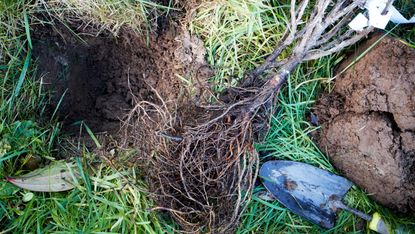

The name doesn't sound promising but by planting bare root trees in winter you'll be surprised by how quickly you get results. The best time to plant trees is always during the dormant months of winter, as long as the ground isn't frozen. This is especially important for bare root trees, which are usually only available from November until the end of February. They might look half dead, but don't be put off by their appearance as in a couple of years’ time your twiggy specimens will have matured into sturdy and attractive leafy young trees.
Winter is the optimum time to plant bare root trees as the ground is damp and the plants have more time to get established and settle their roots before they come into growth in spring. Container-grown trees and shrubs meanwhile can go in the ground at any time of year, providing the soil isn’t frozen or waterlogged.
There are various things you need to do to give your young bare root trees the best possible chance. Keep reading for our easy-to-follow tips on planting bare root trees, then head over to our guide on how to compost so you can give your new trees the best possible start on their growing journey.
What are the benefits of planting bare root trees?
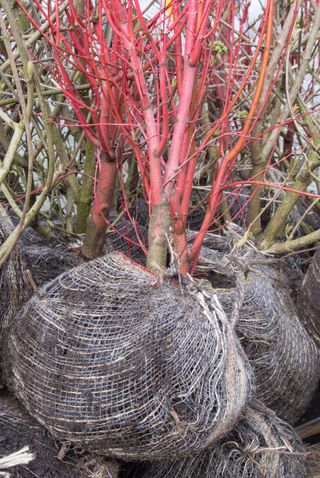
Opting for bare root trees is a budget-friendly way to add new trees to your garden
If you don’t mind waiting a couple of years for plants to grow, bare root planting is a cheap and easy way of filling out your garden with trees and shrubs or creating a lovely new hedge. They may look a little barren to start off with, but don’t be deceived as they have robust roots and will grow considerably in their first year. Just remember not to leave their roots exposed too long in the air during planting as they will quickly dry out.
What’s the difference between bare root trees and whips?
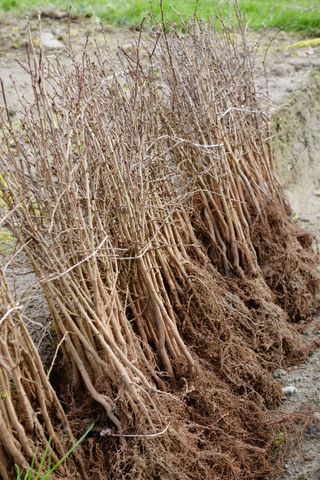
Whips are slender plants without a rootball
Bare root trees arrive in your garden without anything on the rootball except a bag. They will have been growing in a field until shortly before you buy them. Growers dig them up when they're dormant, and the roots are cleaned of soil then packed in moist material for delivery. Whips meanwhile are young and slender 'whippy' plants without a rootball that are also available for planting from November until the end of February, and are generally used for hedging.
How to prepare the soil for planting bare root trees
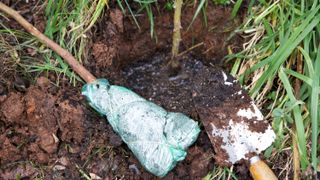
It's important to add well-rotted compost or manure to your soil before planting your bare root tree
Clear the area of the garden you have in mind for your new tree and enrich it as nothing will grow if the soil is either compacted or low on nutrients. Remove any weeds and debris, dig the soil over and add plenty of well-rotted compost or manure. If your soil is heavy clay or frequently becomes waterlogged, make sure you buy a tree variety best suited to these conditions. If the ground is swampy, plant the tree on a mound around 30cm high and 1 metre in diameter to lift the tree roots clear of the heavy soil. If you're planting a hedge, use weed-suppressing membrane and make holes where you want the trees to go.
Already make your own compost but want to up your composting game? Head over to our guide to hot composting to give this method a go.
How to plant a bare root tree
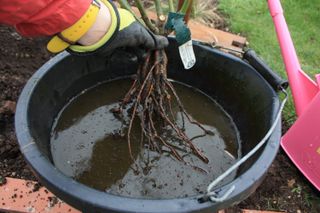
If the roots of your bare root tree are looking very dry, soak them in a bucket of water before planting
When your plants arrive, unwrap them from their packaging and gently loosen the roots. Check the roots are damp and don’t let them dry out, as this is the quickest way of killing them or stunting their growth. If they are dry, immerse the root ball in a bucket of water so they can have a good drink before planting.
Make sure the soil at the bottom of the hole is loosened to provide good drainage for the roots too. Firm them in, jiggling the tree so the soil works down into all the gaps, then attach them to a support and water well. Plant trees at the right depth, as deep as their rootball or up to the soil tidemark on bare-root plants. They will not thrive if planted too deep or too shallow.
If you're adding bare root roses to your garden this year too, head over to our feature on how to plant bare root roses for a step-by-step guide.
Planting a bare root tree in a container
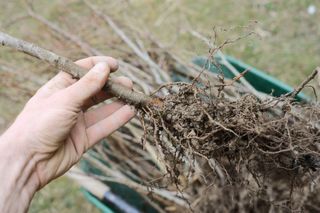
Bare root trees can also be planted in containers, but you need to ensure the container is big enough to allow for plenty of space for the tree to grow
Want to plant your bare root tree in a container rather than in the ground? Here's what you need to do.
1. Immerse the roots in a bowl of water for at least 30 minutes before planting.
2. Make sure the container is large enough for at least two years’ growth. Line the base with crocks.
3. Add the compost and place the tree centrally. Spread its roots so it is evenly balanced.
4. Add more compost, making sure the tree’s knobbly graft is visible. Leave room for watering.
5. Insert a stake into the compost, firm it in and attach the tree making a figure-of-eight knot with twine to avoid chafing the bark.
6. Water the tree well, giving it a really good soaking. Stand the pot on feet and keep it well watered.
How to care for bare root trees
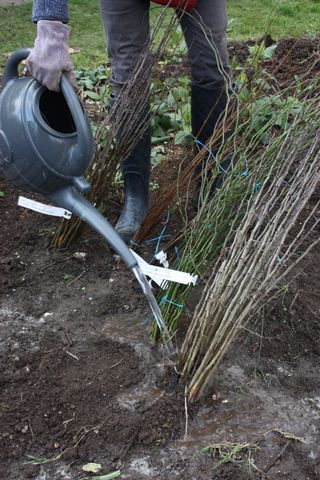
Keep your newly planted bare root tree well watered and the area free from weeds
Post-planting care is critical. Don’t let your tree dry out, but also don’t over-water it either as this can starve the roots of oxygen. To get the balance right, slide a trowel down through the soil to gauge how much moisture is present. Keep the planting area free of weeds and make sure there is around 1 metre of bare soil around the tree so its roots aren’t competing with other plants for water and nutrients. Mulching helps too, but make sure the mulch doesn’t touch the trunk as it can soften and rot the bark. Follow these easy tips and your new tree will soon reward you with a growth spurt!
Head over to our ultimate guide to mulching for expert tips on how to make and use mulch in your garden.
Read more:
- The best trees for small gardens: choose the right one for your space
- The best fast growing hedges: get a new garden boundary, fast
- Our favourite plants with attractive winter bark: add interest with these picks

Lifestyle journalist Sarah Wilson has been writing about gardens since 2015. She's written for Gardeningetc.com, Livingetc, Homes & Gardens, Easy Gardens and Modern Gardens magazines. Having studied introductory garden and landscape design, she is currently putting the skills learned to good use in her own space where the dream is establishing a cutting garden.
-
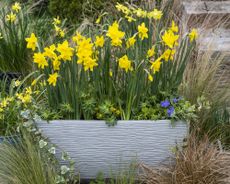 An Update on Gardeningetc
An Update on GardeningetcA word from our publisher
By Beth Murton Published
-
 Do you need to chit potatoes? Find out what the experts say
Do you need to chit potatoes? Find out what the experts sayGrow Your Own Learn how to chit potatoes before planting them in the ground and you’ll be on your way to getting an earlier and bigger harvest
By Drew Swainston Published
